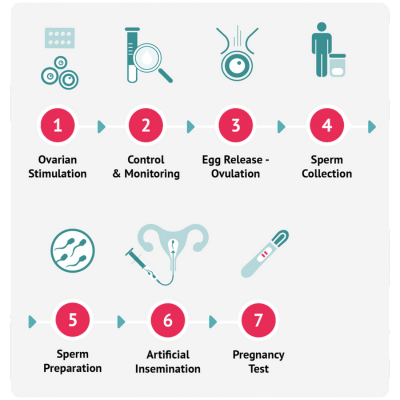Proudly part of the City Fertility Network
Proudly part of the City Fertility Network
 Donor Insemination (DI) is a fertility procedure in which frozen donor sperm is thawed and inserted into a person’s uterus directly around the time of ovulation to achieve a pregnancy. This can also be more broadly known as artificial insemination or intra-uterine insemination.
Donor Insemination (DI) is a fertility procedure in which frozen donor sperm is thawed and inserted into a person’s uterus directly around the time of ovulation to achieve a pregnancy. This can also be more broadly known as artificial insemination or intra-uterine insemination.
Donor insemination is suitable for single individuals with a uterus and same-sex couples. Donor insemination is not suitable for everyone and depends on many factors.
Donor insemination is not recommended for:
Rainbow Fertility has a range of donor sperm available now, with no waitlist. Call our Fertility Advice Team on 1300 222 623 to find out more.
There are three donor insemination treatment options:
Your fertility specialist will select the treatment option that best suits your needs.

The process of donor insemination involving ovulation induction includes the following steps:
Ovarian stimulation involves taking oral medication or follicle-stimulating hormone (FSH) injections at the start of your period to stimulate the ovaries and encourage the growth of multiple follicles containing eggs.
Your fertility specialist will closely monitor your response during ovarian stimulation with ultrasounds and/or blood tests. This is important as ovulation induction medication is powerful and may need to be adjusted to control the number of follicles thus reducing the risk of a multiple pregnancy.
When the follicle(s) reach a certain size a Human Chorionic Gonadotrophin (hCG) injection (often referred to as a ‘the trigger injection’) is administered in preparation donor insemination.
Donor treatment can use fresh sperm or frozen sperm from a known or unknown donor. No matter what sperm is being used, a washed concentrated sample of motile sperm will be used for insemination.
The sperm sample is prepared in a way that concentrates the motile sperm in a small volume. By removing the seminal plasma, debris and sub-optimal sperm, the final preparation allows for the best quality sperm to be used for the donor insemination.
The final stage of donor insemination treatment is the insertion of the prepared sperm directly into the person carrying the pregnancy’s uterus. Your fertility specialist will use a speculum and a disposable catheter to bypass the cervix. Insemination is a simple procedure and just takes a few minutes – many people describe it as being like a Pap smear.
The final stage of donor insemination is called the luteal phase and it’s the two weeks between insemination and the pregnancy test. Many people find this to be the most difficult time to endure. Whilst it’s an exciting and optimistic time, it can often be emotionally charged with expectation and anxiety. You will be encouraged to eat well, stay hydrated and keep busy while you wait for your pregnancy blood test.
You can also download our donor insemination graphic here.
Your pregnancy test is performed two weeks after the insemination. The time between the insemination and your pregnancy test is often emotionally charged with expectation and anxiety. We understand that this can be a difficult time and encourage you to contact your fertility clinic for support.
If your artificial insemination or donor insemination procedure is unsuccessful, we encourage you to have a follow-up appointment with your fertility specialist. At this appointment, plans for further treatment can be made and any questions answered.
In vitro fertilisation (IVF) has a much higher pregnancy success rate than donor insemination with an average pregnancy rate of approximately 42.5%*. It is generally recommended that you move to IVF if donor insemination has been unsuccessful after two. Your fertility specialist will discuss treatment with you at follow-up consultations.
At Rainbow Fertility, we recognise that each person’s path to parenthood is unique. That’s why our fee structure is designed to align with your personalised treatment plan, carefully developed by your Fertility Specialist. The cost of donor insemination, also known as Intra-uterine Insemination (IUI), is $1,050 with your estimated out-of-pocket cost (after Medicare rebate, if eligible) of $975.
You can learn more about our treatment costs here.
Success rates for Intrauterine Insemination (IUI) can vary depending on whether donor sperm or a partner’s sperm is used. Several factors influence these outcomes, and your Fertility Specialist will provide personalised guidance based on your circumstances.
IUI success with partner’s sperm
IUI success with donor sperm
If IUI is unsuccessful after two attempts, moving to in vitro fertilisation (IVF) is generally recommended, as IVF offers significantly higher success rates. Your specialist will help determine the best treatment pathway for you.
The main difference between donor insemination and IVF lies in how fertilisation occurs. With donor insemination, fertilisation happens naturally within the uterus after sperm is placed directly inside, allowing it to meet the egg on its own. In contrast, IVF involves a more controlled process where fertilisation takes place in a laboratory, with the egg and sperm combined outside the body before the embryo is transferred to the uterus.
Potential risks and side effects associated with donor insemination include:
PLEASE NOTE: